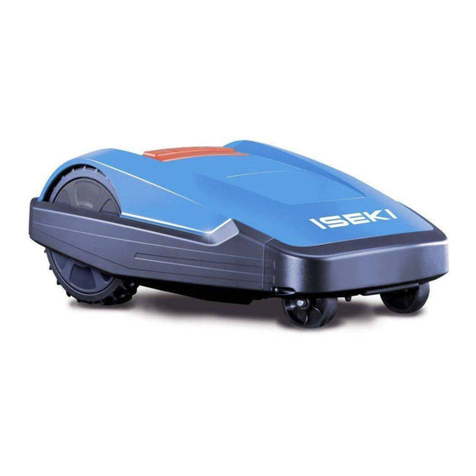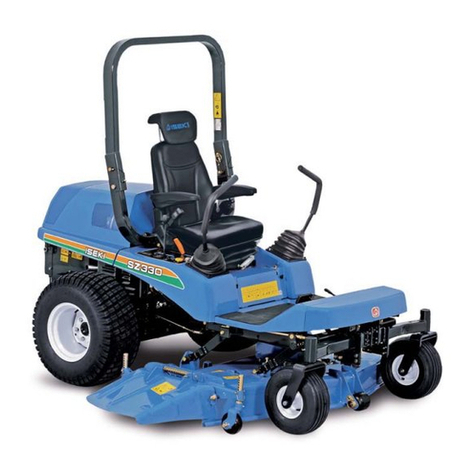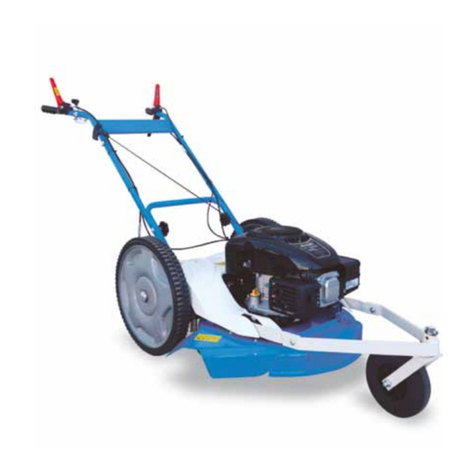
TABLE OF CONTENTS
3
TABLE OF CONTENTS
2.6. PARKING BRAKE LEVER...................... 40
2.7. TILT AND TELESCO LOCK LEVER....... 41
3. FENDER PANEL ........................................... 41
3.1. MOWER LIFT LEVER ............................ 41
3.2. COLLECTOR LIFT LEVER .................... 41
3.3. COLLECTOR DUMP LEVER ................. 42
3.4. THROTTLE LEVER................................ 42
4. OTHER CONTROLS ..................................... 42
4.1. SAFETY SWITCHES.............................. 42
4.2. HST UNLOADING SWITCH................... 42
6. PRE-OPERATIONAL INSPECTION .................... 43
1. INSPECTION ITEMS..................................... 43
2. WAY OF INSPECTION AND
MAINTENANCE............................................. 43
7. OPERATION ........................................................ 44
1. BEFORE STARTING THE ENGINE .............. 44
2. STARTING THE ENGINE.............................. 44
3. TRAVELLING................................................. 46
4. CRUISE CONTROL....................................... 48
5. STOPPING .................................................... 48
6. STOPPING THE ENGINE ............................. 49
8. MAINTENANCE................................................... 50
1. SERVICE ACCESS ....................................... 50
2. ENGINE OIL LEVEL ...................................... 51
3. TRANSMISSION OIL LEVEL (FOR HST
CASE & PTO CASE) ..................................... 52
4. COOLANT LEVEL ......................................... 52
5. FUEL LEVEL ................................................. 53
6. AIR CLEANER............................................... 53
7. FUEL FILTER................................................. 54
8. FUEL HOSES ................................................ 54
9. FAN BELT ...................................................... 55
10.BRAKE PEDAL PLAY .................................... 56
11. NEUTRAL POSITION OF HST...................... 57
12.WHEEL TIGHTENING BOLTS AND NUTS ... 58
13.BATTERY ...................................................... 58
14.TIRE PRESSURE (INFLATION).................... 60
15.STEERING WHEEL....................................... 60
16.ENGINE OIL REPLACEMENT ...................... 61
17.ENGINE OIL FILTER ..................................... 62
18.TRANSMISSION OIL REPLACEMENT......... 62
19. SUCTION FILTERS ....................................... 63
20.RADIATOR .................................................... 64
21.COOLANT REPLACEMENT ......................... 64
22.FUSES AND WIRING .................................... 66
23.HYDRAULIC SYSTEM PARTS ..................... 67
24.SAFETY SWITCHES..................................... 67
25.WASHING OF THE MACHINE...................... 68
26.FILLING DIAGRAM ....................................... 69
27. PERIODICAL INSPECTION TABLE .............. 70
9. STORAGE............................................................ 71
INTRODUCTION...................................................... 1
TABLE OF CONTENTS ........................................... 3
1. FOR SAFE OPERATION ..................................... 5
1. HOW TO BE A SAFE OPERATOR................ 5
2. BEFORE STARTING THE FRONT
MOWER......................................................... 6
3. OPERATION OF THE FRONT MOWER ....... 8
4. OPERATION ON A SLOPE ........................... 11
5. DRIVING ON PUBLIC ROADS...................... 12
6. LOADING ONTO OR UNLOADING FROM A
TRUCK .......................................................... 13
7. WHEN FILLING WITH FUEL......................... 14
8. MOUNTING AND DISMOUNTING OF THE
MOWER DRIVE SHAFT................................ 14
9. INSPECTION AND MAINTENANCE ............. 15
10.MAINTENANCE OF THE ELECTRIC
SYSTEM........................................................ 18
11. TIRES AND WHEELS.................................... 19
12.BEFORE STORING THE FRONT MOWER .. 19
13.LONG TERM STORAGE............................... 20
14.CAUTION LABELS & THEIR POSITIONS .... 21
2. WARRANTY AND AFTER-SALE CARE ............. 28
1. WARRANTY .................................................. 28
2. AFTER-SALE CARE...................................... 28
3. SERIAL NUMBER PLATE ............................. 28
3. SPECIFICATIONS................................................ 29
FRONT MOWER SECTION
4. NAME OF MAJOR COMPONENTS .................... 33
5. CONTROLS AND METERS................................. 34
1. CONTROL PANEL......................................... 34
1.1. STARTER SWITCH................................ 35
1.2. COMBINATION SWITCH ....................... 35
1.3. BEACON SWITCH ................................. 35
1.4. HAZARD SWITCH.................................. 35
1.5. BLOWER PTO SWITCH ........................ 36
1.6. MOWER PTO SWITCH.......................... 36
1.7. BLOWER LOW ROTATION SPEED
SWITCH ................................................. 36
1.8. COLLECTOR EXTENDED WORKING
SWITCH..................................................
36
1.9. PTO LOCK SWITCH .............................. 36
1.10. MONITOR LAMP ARRAY ..................... 37
1.11. FUEL GAUGE....................................... 38
1.12. HOUR METER...................................... 38
1.13. COOLANT TEMPERATURE GAUGE... 38
2. CONTROL PEDALS & LEVERS ................... 39
2.1. BRAKE PEDAL....................................... 39
2.2. HST FORWARD TRAVEL PEDAL.......... 39
2.3. HST REVERSE TRAVEL PEDAL........... 39
2.4. DIF-LOCK PEDAL.................................. 39
2.5. CRUISE CONTROL PEDAL................... 40














































